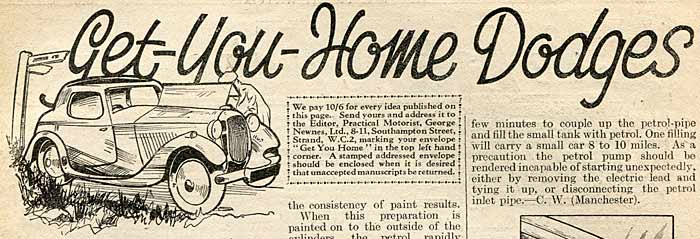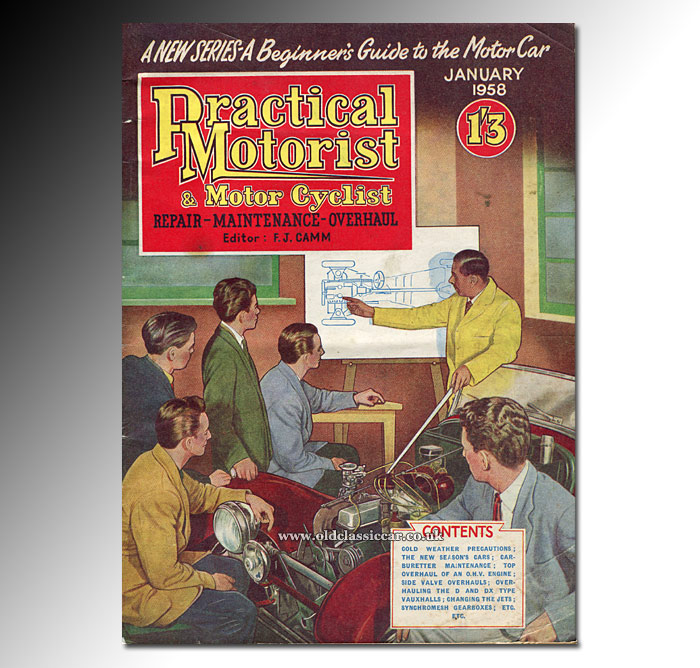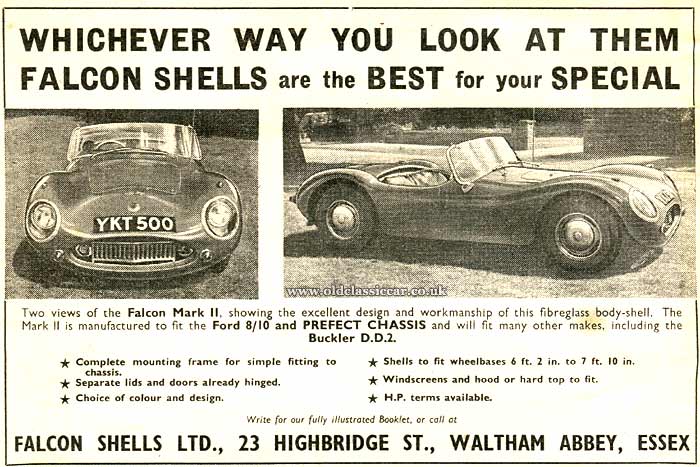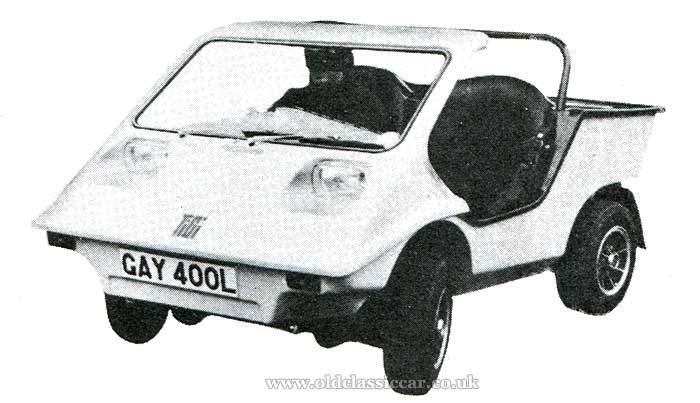Practical Motorist magazine.
Car maintenance at home to most people nowadays, might include running the vacuum cleaner around the
interior on occasions, and topping up the washer fluid when the warning lamp illuminates. But, as battle-scarred old-car fans will know all too well, it didn't always used to be like this. Driveways up and down the land would often bear witness to keen motoring DIY-ers fettling, improving and in some cases resuscitating their ageing motor-cars and motor-cycles. Not for them the misery of trudging around gargantuan shopping centres on a Saturday, pondering their next cappuccino purchase. No, more likely they'd be swapping out the oil seals in their Victor's back axle, perhaps re-spraying part of their Super Snipe's bodywork using a spraygun powered by the air pressure in a spare tyre, or de-coking their Ford Pop's pre-war designed sidevalve engine. It may be something they actually enjoyed doing, or else were obliged to do it when funds didn't allow for employing local garage mechanics to do the work for them.
|
|
Fortunately, until the late 1970s, cars were put together by human beings rather than machines, which made home-spannering a realistic alternative to the local main dealer, or back street garage, servicing. Scrapyards, which could be easily accessed and scoured for parts by anyone, were also a huge help to anyone running and maintaining their own vehicle(s).
|
|
To support this extensive network of home-fiddlers, were a good number of motoring magazines, each packed with handy tips, technical articles, and product features. Practical Motorist was one of them. Others, in the UK, included Car Mechanics, while titles such as Popular Motoring, mixed in hands-on advice with a more rounded look at the motoring world in general.
|
The new magazine for 1934.
"The Practical Motorist", as it was initially titled, first went to print in 1934. Shown below is a copy of Volume 1, Issue Number 5, dated June 9th 1934. In the early years, it was a weekly magazine, although in later years it switched to being published on a monthly basis.
|

|
Re-painting a car.
A gent features on this issue's cover, concentrating hard as he demonstrates the technique of re-spraying part of an Austin 12/6's front wing. This reflects a key article within the magazine, that of re-cellulosing (ie re-painting) cars at home. Tips on preparation, and use of widely-available paint spraying equipment, is given, again aimed at Joe Public in his suburban driveway, rather than a commercial garage worker. The subject of home spraying, opens with the following introduction to the art.
|
|
"It is not generally realised that the modern two- or four-seater family car can be re-cellulosed for a very modest outlay due to the fact that a very efficient spraying apparatus which only costs 5s. is now marketed by several manufacturers, one of the best being that supplied by the makers of "Chemico" spraying cellulose. A useful type is their No.3 "Sprayon" gun, and provided a good motor foot pump is available, nothing more is required except a few tins of "Chemico" spraying cellulose and a certain amount of energy."
|
|
For smaller jobs, a hand-operated sprayer, not unlike the type used to spray insecticides in the garden, was also demonstrated. Quite how successful readers were in putting these recommendations into action, is hard to say, but for every well-painted car out there, there must have been several that didn't go to plan, no doubt upsetting neighbours with either the smell, or quite possibly by contamination made to any unfortunate washing that happened to be hanging outside, downwind of the painter's driveway.
|
"Can-do".
Throughout the magazine though there is a clear "can do" approach. This one issue alone also has features on repairing - not just replacing - cracked engine castings, re-grooving car tyres, looking after an engine's spark plugs correctly (bearing in mind that many pre-war plugs could be disassembled for cleaning), the inner workings of car gearboxes and also fluid flywheels (used by makers such as Daimler and Armstrong-Siddeley for example), Bendix brake adjustment, the design of bevel-gear differentials, dynamo failures, and chassis lubrication. Phew. Interspersed, are a few articles that concern themselves with interesting places to visit in one's car. Owning a pre-war car today can be assisted greatly by having a healthy stash of these old magazines on a handy shelf.
|

|
|
A very interesting section, in all the pre-war copies I have of The Practical Motorist, is titled "Get-You-Home Dodges", where ingenious tips are submitted by the magazine's readers. Advice on soldering a carburettor float for instance, by part submerging it in water to minimise heat spread from the soldering iron, is given. A design of temporary fuel tank, which you strap beneath the bonnet any time that a mechanical pump gives up the ghost, might well help people complete their journey, relying on gravity rather than pump-action to deliver the fuel.
|
|
At the time, The Practical Motorist was still a recent new addition to the newsagents' shelves. As such, the letters page is well populated with enthusiastic comments from thankful readers. Others choose to raise points about their own motoring experiences, and things that they believe should be addressed by the authorities post-haste. While the language reflects the era, the topics are not all that dissimilar to those that people write about today. For example, the oft- thorny topic of car drivers and cyclists attempting to share the same piece of tarmac ...
|
"A Foolish Policy.
Sir - There seems to be a growing antagonism between the cyclist and the motorist, and I must confess that it seems incredible to me why this should be so. Presumably it dates from the attempt to introduce legislation to compel the carrying of a rear light, but a run on our main roads at the week-end now produces some most interesting examples of the attitude of the cyclist towards the man with a car. During this week-end I came several times upon groups of cyclists, riding abreast and, as usual, spread out across the road. I was only cruising at 20 mph, enabling my passengers to enjoy the scenery, and when I sounded the horn - in their interests to give them warning that there was someone else on the road - two or three of them turned round and passed most uncomplimentary remarks."
|
|
Various products are advertised throughout the magazine, but the only new-car manufacturer that chose to promote their wares was Hillman, occupying the entire back page of The Practical Motorist, with an advertisement for their Minx saloon.
|
|
Research suggests that this first incarnation of the magazine continued until April 1940, until the shortage of paper due to WW2 forced publication to cease. It wouldn't re-appear until 1954.
|
To the 1950s.
The re-born magazine of 1954 and onwards was now titled "Practical Motorist & Motor Cyclist", and had become a monthly rather than weekly publication. Earlier issues incorporated photographs on their covers. Now though, attractive artwork could be used, presumably because only one rather than four or five different covers had to be designed per month. The copy shown here dates to January 1958, an instructor is teaching his students the inner workings of a typical motor-car.
|

|
|
Far more advertising can be found in this later example, when compared to the pre-war issue, but equally there are more articles that will have appealed to hands-on home mechanics.
|
Special-building.
By the late 1950s, car enthusiasts were not just looking after cars, as more and more were choosing to build their own, often using creaky old saloons as donors. While special-building had always taken place, the growing availability of fibreglass bodyshells in the late 1950s - mostly sporting in spirit - allied to a growing market in tuning parts, led to a boom time for the hobby of home-building your own car. Advertisements reflect this growing interest in the subject. One of the more prolific producers of racy-looking bodyshells, designed to clad distinctly non-racy Ford Pop running gear, was Falcon Shells Limited, of Waltham Abbey in Essex. A half-page advert promotes the Falcon Mk2, one of the better-looking and better-finished of the fibreglass bodyshells that were available. I've owned an Ashley and a Nickri, while a friend of mine owns a Falcon Mk2, albeit running the 948cc BMC A-Series engine, rather than the more usual 1172cc Ford engine. A section looking at 1950s/1960s Ford-based specials can be seen here.
|

|
|
On the subject of advertising, inside the rear cover is an advertisement for Notek "Blue Spots" lamps, endorsed by racing driver Peter Collins. Tragically, he'd lose his life just a few months later, following an accident that occurred while competing at the 1958 German Grand Prix.
|

|
|
The core "raison d'etre" for the magazine continues to be home maintenance, joined by complementary features that explain aspects of both modern and older car design trends. As more and more people were now able to consider buying a new, or nearly-new, car, so too did the magazine reflect these changing times, with various pieces that looked at, for example, upcoming new-car launches planned for the year ahead.
|
New cars due this year.
The centre spread in fact is given over to upcoming new-car launches. For those with reasonably deep pockets, cars such as the 2.4 litre Jaguar saloon which was soon to join the range, might be of interest (selling alongside the existing 3.4), while those who sought out thrills while behind the wheel, may well have had their interest piqued by the raffish Allard "Gran Tourismo", a two-door sporting coupe. Those with lower, family-orientated, aspirations, would probably have felt more comfortable reading about the new Standard Pennant (actually a re-working of the old Standard 10), or the slightly dumpy Hillman Husky (a car I like the look of myself). Enthusiastic motorists on a budget though would probably have to settle for the middle-ground cars, cars that were pepped-up versions of more humble motors. The Riley One-Point-Five, Singer Gazelle Convertible, and the related Sunbeam Rapier, tended to fall into this category, based as they were on less glitzy models in the family.
|
|
The original audience for the magazine though was still ably catered for, with many articles included to help the home-maintainer do their work. Tips on re-trimming a car's interior, would benefit not only people who drove older cars, but anyone building their own "special". A comprehensive multi-page feature discusses the best way to go about overhauling a typical sidevalve engine, while motorcyclists would no doubt benefit from a three-page article that focuses on their particular needs. If you've ever wondered how to go about dismantling a synchromesh gearbox, look out for a copy of January 1958's issue.
|
The magazine evolves in the 1960s.
In 1959, the "& Motor Cyclist" part of the title was dropped. The full-colour cover illustrations continued until 1960, after which the artwork was simplified somewhat to - typically - vehicles presented on a plain background only. In February 1961, colour photographs replaced the artwork entirely, and the typeface of the title altered in mid-1962. It again changed in mid-1966, and received further tweaks most seasons after that.
|
Practical Motorist, 1973.
The April 1973 copy of PM was priced at 15 pence, and like all issues printed in this year, had returned to including an element of illustration to the cover. Drawing the reader in, are mentions of a Vauxhall Victor engine rebuild article, while a red P6 Rover is used to highlight an article about buying used cars. An MGB Roadster introduces the topic of back-ache while at the wheel, and a green four-door Hillman Avenger promises technical information and specifications on Hillman's saloon.
|

|
|
Build quality on most cars built in this era was pretty dismal, so even owners of fairly modern cars were forced to roll up their sleeves and dig out their sets of spanners, to keep their cars on the road. Rust killed many a car before its time, and there are plenty of products included in the PM's pages to help thwart the metal moth. One I remember well from my youth, and that has a full-page advertisement for it, is Trustan 23. It was designed to stabilise existing rot and form a coating over it, ready for filler and paint. How effective it was I'm not sure, but if it just slowed down the march of the rust, then it was worth a try. Even Woolworth's ran adverts for Turtle Wax's "Rust Eater", while elsewhere a "before and after" advert, using a once-tatty Mk1 Mini, celebrates the benefits of using Kurust's rust-converting products. Plastic Padding car body filler, a DIY favourite for many years, also receives plenty of coverage.
|
|
By the early 1970s, the "glory days" of special-building had pretty much disappeared. Kit-cars though were becoming popular. As with specials, they were designed with home-build in mind, and were in effect cars in kit form, still offering plenty of scope for customisation. One was the odd-looking TiCi, or "Titchy" as it was to be pronounced. An ugly (IMO) two-seater, it measured a measly 7ft 5ins long and used the running gear torn out of any available rusty Mini, of which there were plenty around after 14 years of production.
|

|
|
The magazine continued to sit on the shelves of newsagents well into the 1990s, at times simply titled "Motorist", and later reverting to "Practical Motorist", before being wound up for good towards the end of the 1990s.
|
|
A couple of maintenance log books, produced by Practical Motorist in conjunction with BP and updated by an Austin A35 owner, can be found on this page. They date to 1961 and 1961.
|
|
Return to the car magazines section, to read about many other titles.
|











